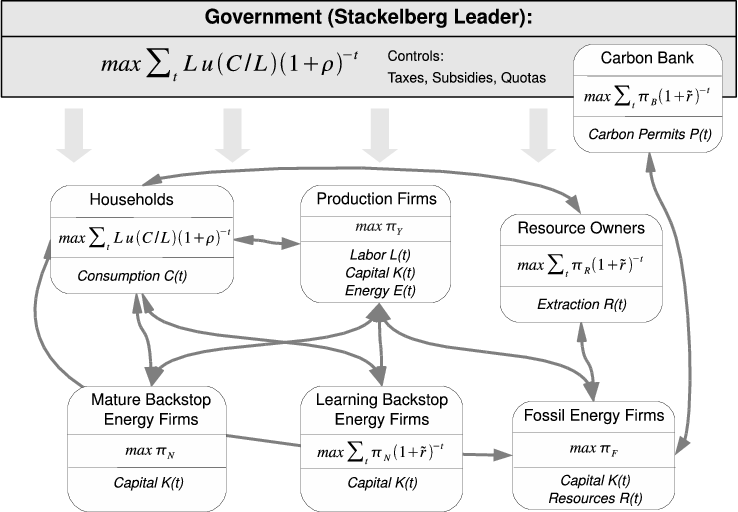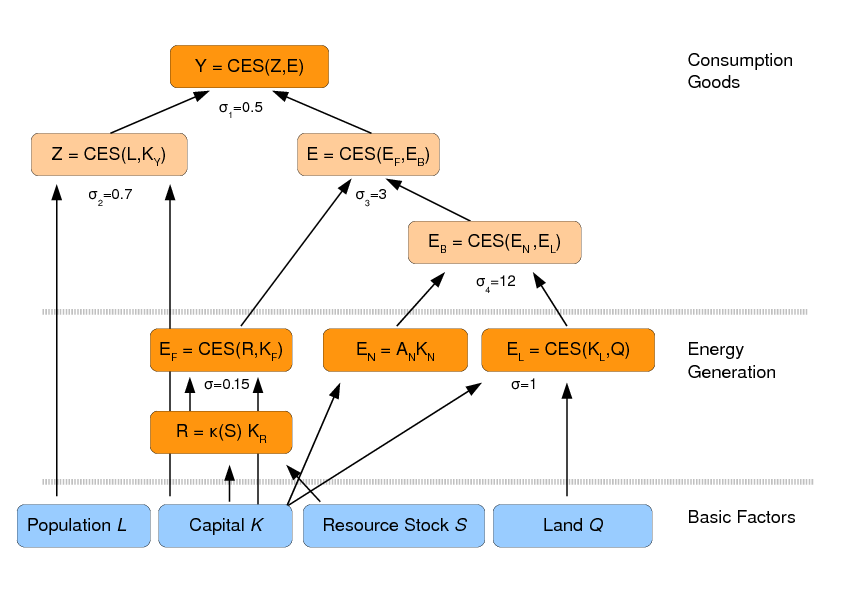Aim of the model
The aim of PRIDE is to provide an integrated assessment of policy instruments for cost-efficient climate mitigation. The model represents utility and profit-maximizing economic sectors that are relevant for energy-economic mitigation policy, i.e. households, production, fossil and renewable energy firms and fossil resource owners. Furthermore, a government imposes policy instruments (taxes, subsidies, permits, quotas, feed-in-tariffs, etc.) in order to achieve climate protection. The model is calibrated at a global scale in order to consider the dynamics of fossil resource supply appropriately.
Typical research questions are:
- What is the optimal policy mix (carbon pricing and technology policy) to achieve low-carbon stabilization and least costs?
- What is the performance of several second-best policies (carbon pricing only, renewable energy subsidies only, etc.) compared to the first-best policy mix?
- How do several first-best and second-best instruments influence energy prices, fossil and renewable energy rents, labor and capital income, and taxes?
Market failures integrated in PRIDE:
- Open-access atmospheric carbon budget (missing carbon price)
- Learning-by-doing spillovers
- Discount rate mark-ups in several sectors (e.g. due to insecure property rights/risk premiums)
- Imperfect competition in financial intermediation
Model structure
| Optimization and market equilibrium | Technologies |
|---|---|
 |
 |
Model versions
PRIDE 1.0: Basic model with 3 generic energy sources: fossil energy, non-learning backstop energy, learning backstop energy.
Extensions include
- climate change damages module (work in progress)
- financial intermediation of investment flows
- central bank credit
Work in progress
- Lessmann, K. and M. Kalkuhl: Climate Finance Intermediation: Interest Spread Effects in a Climate Policy Model, available on SSRN
- McConnell/Yanovski/Lessmann: Central Bank Collateral as an Instrument for Climate Mitigation, available on SSRN
Publications and supplementary material
- Kalkuhl, M., Edenhofer, O., Lessmann, K. (2015): "The Role of Carbon Capture and Sequestration Policies for Climate Change Mitigation", Environmental and Resource Economics Volume 60, Issue 1, pp 55-80, doi:10.1007/s10640-013-9757-5, PDF.
- Kalkuhl, M., Edenhofer, O., Lessmann, K. (2013): Renewable energy subsidies: Second-best policy or fatal aberration for mitigation? Resource and Energy Economics, 35 (3), pp. 217-234, PDF.
- Kalkuhl, M., O. Edenhofer and K. Lessmann (2011): "Learning or Lock-in: Optimal Technology Policies to Support Mitigation". Resource and Energy Economics (in press). Journal version. Working Paper Version. Supplementary Material
- Kalkuhl, M., O. Edenhofer and K. Lessmann (2011): "Renewable energy subsidies: Second-best policy or fatal aberration for mitigation?" FEEM Working Paper 48.2011.
For question about PRIDE please contact Matthias Kalkuhl.





